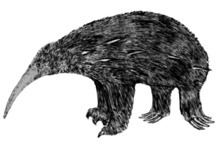Kingdom Animalia Class Mammalia Family Tachyglossidae Scientific name Zaglossus hacketti | Phylum Chordata Order Monotremata Genus Zaglossus Rank Species | |
 | ||
Similar Megalibgwilia, Long‑beaked echidna, Sir David's long‑beaked echidna, Eastern long‑beaked echidna, Western long‑beaked echidna | ||
Zaglossus hacketti is an extinct species of long-beaked echidna from Western Australia that is dated to the Pleistocene. It is known only from a few bones. It was about 1 m long and probably weighed about 30 kg (66 lb). This makes it the largest monotreme known to have ever lived. Due to the lack of cranial material, placement of Z. hacketti into the modern long-beaked echidna genus Zaglossus is uncertain.
Contents
Description
At around 1 metre long, 0.5 metres tall and about 30 kg, Z. hacketti was the largest monotreme known to have existed. Z. hacketti had longer, straighter legs than any of the modern echidnas. Augee (2006) speculates that this feature made the animal more adept at traversing through thickly wooded forests.
Discoveries
Fossils of Z. hacketti have been discovered in Mammoth Cave, Western Australia. The material is poor, mostly vertebra and leg bones, and the cranial material is completely absent, making Z. hacketti's placement into the genus Zaglossus uncertain. Some of the fossils have incisions and burn marks, suggesting that Z. hacketti was at least occasionally hunted by humans.
Aboriginal rock art found in Arnhem Land in the Northern Territory may represent Z. hacketti or the extant western long-beaked echidna.
